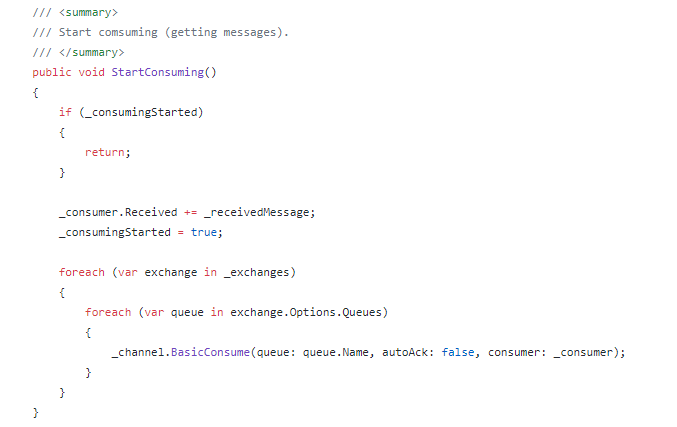Dear Kashif, thank you for asking.
Frankly speaking I have not had a case in which one application uses two exchanges. So I need a little bit of time to investigate and reproduce that.
So I am aware of the problem and will try to give you detailed answer asap. To be more precise if I have enough time I will try to do it next week.
Hi Anthony,
I wanted to clear my understanding on the following workflow -
Let's say in ServiceX we have an Exchange 'A' which has the following queues q1, q2 & Exchange 'B' which has queue 'q3'. So what we do is declare exchange settings, like this, "ExchangeA": { "Type": "direct", "Durable": true, "AutoDelete": false, "DeadLetterExchange": "exchange.a.dlx", "RequeueFailedMessages": true, "Queues": [ { "Name": "q1", "Durable": true, "AutoDelete": false, "RoutingKeys": [ "q1.routing.key" ], "Arguments": { "queue-mode": "lazy" } }, { "Name": "q2", "Durable": true, "AutoDelete": false, "RoutingKeys": [ "q2.routing.key" ], "Arguments": { "queue-mode": "lazy" } } ] }
"ExchangeB": { "Type": "direct", "Durable": true, "AutoDelete": false, "DeadLetterExchange": "exchange.b.dlx", "RequeueFailedMessages": true, "Queues": [ { "Name": "q3", "Durable": true, "AutoDelete": false, "RoutingKeys": [ "q3.routing.key" ], "Arguments": { "queue-mode": "lazy" } }, ] }
This setting will be used in the QueueService.cs => StartExchange() & StartQueue() to build exchange and queue bindings. Now as a convention stated by Rabbit Mq we declare Exchange and queue bindings in each app service that depends on using the same as a publisher or consumer.
Further in this example, let me state that ServiceX is a publisher publishing messages in q1, q2 and a consumer consuming from queue q3, well in this case what we do is get the IQueueService instance and say .StartConsuming() which brings us to the part where I need some clarification - QueueService.cs => StartConsuming() If we see this method
You can notice that it will iterate through each exchange [ExchangeA & ExchangeB] and bind consume event to all the queues in the exchange, which effectively means that ServiceX now has become a consumer from q1, q2, q3 which is not intended in this example. This leads to a potential issue of a direct route messaging becoming a worker queue (ServiceX as one of the consumer ) messaging and ServiceX hogs on its own published messages (in q1 or q2) resulting in intended consumer not receiving it.
In my example above please feel free to throw in light, if there is any short coming in my understanding or if you think this is an intended code workflow to follow a convention I am unaware of or if it is a potential issue according to you as well.
Potential fix would be to provide flexibility to the developer to define a setting in RabbitMqQueueOptions to say 'isConsumer' which in turn can be used to filter in StartConsuming function to avoid declaring a service as a consumer on queues that it is not intended to consume. Let me know what you think.
Regards, Kashif